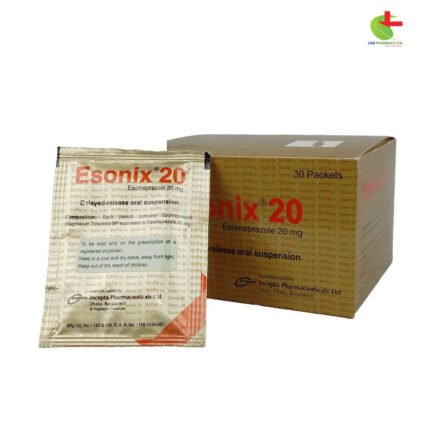Clindacin Suspension
280.00৳ Bottle (100ml)
- Clindacin is a lincosamide antibiotic effective against various infections caused by susceptible anaerobic and gram-positive bacteria, including skin, respiratory, and dental infections.
- It is available in capsule, oral solution, and injection forms, with dosing adjusted based on infection severity and patient age.
- Caution is advised in patients with a history of gastrointestinal issues, and it should not be used concurrently with erythromycin.
- Clindacin is categorized as Pregnancy Category B and should only be used in pregnancy and lactation when clearly needed.
- Proper storage is essential, keeping it below 30°C and away from light and moisture.
 Brand
Brand
|
Incepta Pharmaceuticals Ltd |
|---|---|
 Generics
Generics
|
Clindamycin |
 Type
Type
|
Powder for Suspension |
Indications
Clindacin is effective for treating a variety of infections caused by susceptible anaerobic bacteria and certain strains of gram-positive bacteria, including Streptococci, Staphylococci, and Pneumococci. It is indicated for:
- Upper and lower respiratory infections
- Skin and soft tissue infections
- Bone and joint infections
- Pelvic infections
- Intra-abdominal infections
- Septicemia and endocarditis
- Dental infections
Additionally, Clindacin may serve as an alternative therapy in conjunction with quinine or amodiaquine for managing multi-drug resistant Plasmodium falciparum infections.
Always use medication as directed by a registered healthcare professional.
Description
Clindacin is a semisynthetic antibiotic belonging to the lincosamide class, effective against infections caused by specific microorganisms. It targets:
- Aerobic gram-positive cocci: Staphylococcus aureus, Staphylococcus epidermidis (both penicillinase and non-penicillinase strains), Streptococci, and Pneumococci.
- Anaerobic gram-negative bacilli: Species of Bacteroides and Fusobacterium.
- Anaerobic gram-positive non-spore forming bacilli: Including Propionibacterium, Eubacterium, and Actinomyces.
- Anaerobic and microaerophilic gram-positive cocci: Such as Peptococcus, Peptostreptococcus, and microaerophilic streptococci, including C. perfringens.
Dosage & Administration
Clindamycin Capsules:
- Serious Infections: 150 mg – 300 mg every six hours.
- More Severe Infections: 300 mg – 450 mg every six hours.
To prevent esophageal irritation, take Clindacin capsules with a full glass of water. Research indicates that a 300 mg dose of Clindamycin maintains plasma concentrations over MIC90 for more than 12 hours, supporting a twice-daily dosing schedule for skin and respiratory tract infections. For bone and joint infections or diabetic foot infections, the dosage may increase to 300 mg three to four times daily.
Clindamycin Powder for Oral Solution:
- Serious Infections: 8-12 mg/kg/day divided into 3 or 4 doses.
- Severe Infections: 13-16 mg/kg/day divided into 3 or 4 doses.
- More Severe Infections: 17-25 mg/kg/day divided into 3 or 4 doses.
For pediatric patients under 10 kg, a minimum dose of 37.5 mg (1/2 teaspoon) three times daily is recommended.
Clindamycin IV/IM Injection:
Adults:
- Serious Infections: 600-1200 mg/day in 2-4 doses.
- More Severe Infections: 1200-2700 mg/day in 2-4 doses.
- For critical infections, doses may exceed these recommendations; doses of up to 4800 mg daily have been safely administered intravenously. Single IM injections over 600 mg are not advised.
Neonates (under 1 month): 15 to 20 mg/kg/day in 3 to 4 doses.
Pediatric Patients (1 month to 16 years):
- 20 to 40 mg/kg/day in 3 or 4 doses, with higher doses for severe infections.
- Transition from parenteral to capsule form is permissible based on clinical judgment.
- For beta-hemolytic streptococcal infections, treatment should continue for at least 10 days.
Always use medication as directed by a registered healthcare professional.
Interactions
Clindacin may enhance the effects of other neuromuscular blocking agents, so caution is advised for patients on such treatments. Avoid concurrent administration with erythromycin due to potential antagonistic effects.
Contraindications
Clindamycin is contraindicated in patients with known hypersensitivity to clindamycin or any of its components.
Side Effects
Common side effects of Clindacin include abdominal pain, esophagitis, esophageal ulcers, nausea, vomiting, diarrhea, itching, skin rashes, and urticaria.
Pregnancy & Lactation
Classified as Pregnancy Category B, Clindamycin can cross the placenta. Its use should be limited to situations where it is clearly necessary during pregnancy. Clindamycin may also be excreted in breast milk, so nursing mothers should avoid its use unless absolutely required.
Precautions & Warnings
Prescribe Clindacin with caution in patients with a history of gastrointestinal disorders, especially colitis.
Use in Special Populations
Newborns and Infants: Monitor organ system function when administering Clindacin to newborns and infants (birth to 16 years).
Geriatric Use: No dosage adjustments are typically required for older adults.
Overdose Effects
Overdose incidents with orally administered Clindacin are rare. Expected adverse reactions may mirror those seen with standard dosages, though unforeseen effects may occur. Hemodialysis and peritoneal dialysis are ineffective in removing Clindacin from serum; overdose should be managed with simple gastric lavage, as no specific antidote exists.
Therapeutic Class
Macrolides
Reconstitution
For Powder for Oral Solution: Shake the bottle to loosen the powder. Add 80 ml of boiled and cooled water to the dry mixture. For optimal mixing, add the water in two portions, shaking well after each addition until fully dissolved. Store tightly closed and use within 2 weeks if kept at room temperature.
For IV Injection: Clindacin phosphate must be diluted before administration. The concentration should not exceed 18 mg/ml, and infusion rates must not exceed 30 mg/min. Avoid administering over 1200 mg in a single one-hour infusion. Intramuscular injections should not exceed 600 mg without dilution.
Storage Conditions
Store below 30°C, protected from light and moisture, and out of reach of children.













Reviews
There are no reviews yet.